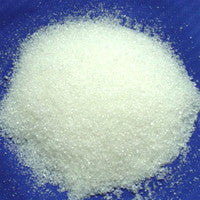CITRIC ACID ANHYDROUS
Technical Grade
Cosmetic Grade
Citric acid is a weak organic acid but is a slightly stronger acid than typical carboxylic acids. It is found naturally in citrus fruits and made industrially by fermenting sugars (usually with Aspergillus niger).. Anhydrous means that the chemical has no water of crystallisation and is in a dry, granulated, free-flowing form. It is easily soluble in water and ethanol, but is insoluble in ether and chloroform.
Properties of citric acid anhydrous:
- CAS number: 77-92-9
- Appearance: white granular solid
- Formula: C6H8O7
- Density: 1.665 g/cm3
- Solubility in water: 133 g/100 ml (20C)
- Melting point: 153-154C
- Autoignition temperature: 1010C
- Explosion Limits: Lower:28 Upper: 2.29
Uses for Citric acid Anhydrous
Cosmetics & personal care
-
pH adjuster / buffer: Set leave-on products ~pH 4.0–5.5; rinse-off often pH 4.5–6.5.
-
Chelator (mild): Helps stability of peroxides, fragrances, and colorants by binding metal ions.
-
Typical use: 0.05–0.5% for fine pH trims; up to ~1% in buffers.
-
Note: Pre-dissolve to a 10% w/w solution for controlled additions.
- When applied to hair, citric acid opens up the outer layer, also known as the cuticle. While the cuticle is open, it allows for a deeper penetration into the hair shaft. It can be used in shampoo to wash out wax and colouring from the hair.
Cleaning & industrial
-
Descaler / limescale remover: 5–10% solutions for kettles, bathrooms, heat-exchangers; dissolves CaCO₃.
-
Metal ion sequestrant: Improves detergent performance, especially in hard water.
-
Effervescent systems: With sodium bicarbonate for foaming cleaners, bath bombs, denture tablets, etc.
-
Oxidizer systems: Part of citrate buffers to stabilize hydrogen peroxide and optimize activity (pH ~4–5.5).
- Pool/spa: Minor pH tweaks and stain removal (spot use).
- Citric acid's ability to chelate metals makes it useful in soaps and laundry detergents. By chelating the metals in hard water, it lets these cleaners produce foam and work better without need for water softening. In a similar manner, citric acid is used to regenerate the ion exchange materials used in water softeners by stripping off the accumulated metal ions as citrate complexes.
- Citric acid is the active ingredient in some bathroom and kitchen cleaning solutions. A solution with a 6% concentration of citric acid will remove hard water stains from glass without scrubbing. In industry it is used to dissolve rust from steel.
- Citric acid is also used as a stop bath in photography. The developer is normally alkaline, so a mild acid will neutralize it, increasing the effectiveness of the stop bath when compared to plain water.
- Citric Acid is used to regenerate the ion exchange materials used in water softeners by stripping off the accumulated metal ions as citrate complexes.
- It is used in conjunction with sodium bicarbonate to make 'Bath bombs' which react together and fizz when placed in water.
Practical tips
-
Buffering: Pair citric acid with sodium citrate to make robust pH 3–6 buffers (useful for peroxide cleaners, shampoos, toners). As a rule of thumb, citric acid lowers pH; sodium citrate raises it—titrate to target.
-
Peroxide cleaners (tie-in): For a 3–6% H₂O₂ cleaner, buffer to pH ~4.5–5.0 using a small aliquot of 10% citric acid solution; add a chelator (e.g., GLDA 0.3–0.5%) for extra stability.
-
Handling: It’s hygroscopic—keep sealed, store cool & dry. Break up lumps before weighing for accuracy.
-
Compatibility: Reacts with carbonates/bicarbonates to release CO₂ (effervescence). Avoid mixing dry with strong oxidizers or bases unless process-controlled.
-
Equipment: Stainless steel (304/316) or HDPE/PP. Avoid mild steel (corrosion).
Quick mini-recipes
-
10% Citric Acid Solution (pH trim stock):
Dissolve 10 g citric acid anhydrous in 90 g water. Add dropwise to your batch while checking pH. -
Descaler Spray (bathroom/kettle):
Water q.s. 100%, Citric acid 7%, Nonionic surfactant 0.5–1%, fragrance optional. Spray, dwell 5–10 min, rinse. -
Citrate Buffer for Peroxide Cleaner (approx. pH 4.8):
Water q.s. 100%, Citric acid 0.20%, Trisodium citrate 0.12%. Verify and fine-tune with a pH meter.
Anhydrous vs. monohydrate
-
Monohydrate MW: 210.14 g/mol (≈8–9% crystal water).
-
Substitution:
-
To replace monohydrate with anhydrous, use 0.914× the mass.
-
To replace anhydrous with monohydrate, use 1.094× the mass.
-
-
Why choose anhydrous? Better shelf life in dry mixes; avoids premature effervescence; flows well for tableting/granulation.
PLEASE NOTE: This product is not for human or animal consumption.
Health & Safety
Risk Phrases: R 36/37/38 Irritating to eyes, respiratory system and skin.
Safety Phrases: S 26 In case of contact with eyes, rinse immediately with plenty of water and seek medical advice. S 37/39 Wear suitable gloves and eye/face protection.
